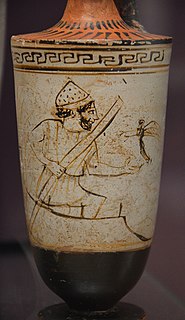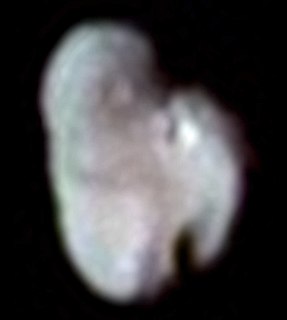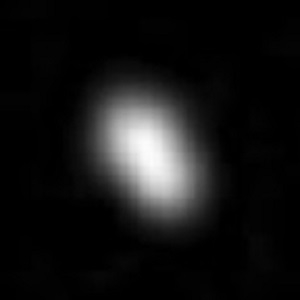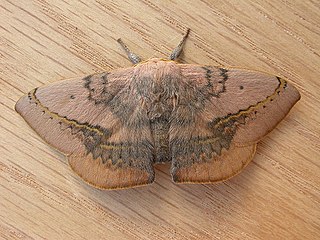Related Research Articles

In astronomy, a double planet is a binary system where both objects are of planetary mass.
A synchronous orbit is an orbit in which an orbiting body has a period equal to the average rotational period of the body being orbited, and in the same direction of rotation as that body.

Pluto is a dwarf planet in the Kuiper belt, a ring of bodies beyond the orbit of Neptune. It was the first and the largest Kuiper belt object to be discovered. After Pluto was discovered in 1930 it was declared to be the ninth planet from the Sun. Beginning in the 1990s, its status as a planet was questioned following the discovery of several objects of similar size in the Kuiper belt, including the dwarf planet Eris. This led the International Astronomical Union (IAU) in 2006 to formally define the term "planet" — excluding Pluto and reclassifying it as a dwarf planet.

Charon, also known as (134340) Pluto I, is the largest of the five known natural satellites of the dwarf planet Pluto. It has a mean radius of 606 km (377 mi). Charon is the sixth-largest trans-Neptunian object after Pluto, Eris, Haumea, Makemake and Gonggong. It was discovered in 1978 at the United States Naval Observatory in Washington, D.C., using photographic plates taken at the United States Naval Observatory Flagstaff Station (NOFS).

In Greek mythology and Roman mythology, Charon or Kharon is a psychopomp, the ferryman of Hades who carries souls of the newly deceased across the river Styx that divided the world of the living from the world of the dead. A coin to pay Charon for passage, usually an obolus or danake, was sometimes placed in or on the mouth of a dead person. Some authors say that those who could not pay the fee, or those whose bodies were left unburied, had to wander the shores for one hundred years, until they were allowed to cross the river. In the catabasis mytheme, heroes – such as Aeneas, Dionysus, Heracles, Hermes, Odysseus, Orpheus, Pirithous, Psyche, Theseus and Sisyphus – journey to the underworld and return, still alive, conveyed by the boat of Charon.

James Walter "Jim" Christy is an American astronomer.

Nix is a natural satellite of Pluto, with a diameter of 49.8 km (30.9 mi) across its longest dimension. It was discovered along with Pluto's outermost moon Hydra on 15 June 2005 by the Pluto Companion Search Team. It was named after Nyx, the Greek goddess of the night. Nix is the third moon of Pluto by distance, orbiting between the moons Styx and Kerberos.

Hydra is a natural satellite of Pluto, with a diameter of approximately 51 km (32 mi) across its longest dimension. It is the second largest moon of Pluto, being slightly larger than Nix. Hydra was discovered along with Nix by the Pluto Companion Search Team in June 2005. It was named after the Hydra, the nine-headed underworld serpent in Greek mythology. By distance, Hydra is the fifth and outermost moon of Pluto, orbiting beyond Pluto's fourth moon Kerberos.

The dwarf planet Pluto has five natural satellites. In order of distance from Pluto, they are Charon, Styx, Nix, Kerberos, and Hydra. Charon, the largest of the five moons, is mutually tidally locked with Pluto, and is massive enough that Pluto–Charon is sometimes considered a double dwarf planet.

Charon's obol is an allusive term for the coin placed in or on the mouth of a dead person before burial. Greek and Latin literary sources specify the coin as an obol, and explain it as a payment or bribe for Charon, the ferryman who conveyed souls across the river that divided the world of the living from the world of the dead. Archaeological examples of these coins, of various denominations in practice, have been called "the most famous grave goods from antiquity."

Anthela varia, the variable anthelid, is a moth of the family Anthelidae. The species was first described by Francis Walker in 1855. It is found in the coastal areas of southern Western Australia, southern Queensland, New South Wales, and Victoria.

Anthela is a genus of moths of the family Anthelidae. The genus was erected by Francis Walker in 1855.
Anthela binotata is a moth of the Anthelidae family. The type location is Peak Down.
Anthela ekeikei is a moth of the Anthelidae family. It is found in New Guinea
Anthela inconstans is a moth of the Anthelidae family. It is found in New Guinea.
Anthela limonea is a moth of the Anthelidae family. It is found in Australia.
Anthela odontogrammata is a moth of the Anthelidae family. It is found in New Guinea.
Anthela trisecta is a moth of the family Anthelidae first described by Thomas Pennington Lucas in 1898. It is found in Australia.

The geology of Charon are the characteristics of the surface, crust, and interior of Pluto's moon Charon. Charon's diameter is 1,208 km (751 mi)—just over half that of Pluto. Charon is sufficiently massive to have collapsed into a spheroid under its own gravity.
References
- ↑ Beccaloni, G.; Scoble, M.; Kitching, I.; Simonsen, T.; Robinson, G.; Pitkin, B.; Hine, A.; Lyal, C., eds. (2003). "Anthela charon". The Global Lepidoptera Names Index . Natural History Museum.
| This article on a moth of the family Anthelidae is a stub. You can help Wikipedia by expanding it. |